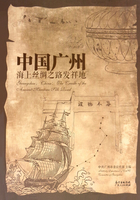
X. "Canton Fair" in the Ming Dynasty
The mid of the Ming dynasty was the transitional period for China's oversea trade, witnessing the gradual decline of the tribute trade and the rise of a dominant merchant trade. A new administrative mechanism came into being that included taxation on private goods in the tribute trade and taxation on merchant trade. In 1553, the 32nd year of Emperor Jiajing, the Portuguese entered Macau marking the start of the trade between the East and the West. Macau, as the important stronghold, rose up rapidly becoming the hub of the international trade of the Far East. The mono-structure of the Canton Trade was replaced by the dual-center structure of Guangzhou-Macao.
The Ming court issued a decree that the Portuguese were not allowed doing business in public in Guangzhou, while they were permitted to do business only in Macau with merchants from different countries. They paid shipping tax only to the Ming dynasty. To change this situation, Guangdong government started from 1578 (the 6th year of Emperor Wanli) on to hold a "trade fair" in Guangzhou; and in 1580, the 8th year of Emperor Wanli, starting to hold it twice a year on spring and summer. In the Fair, merchants from different countries (Portuguese included) were permitted to trade in Guangzhou, thus moving oversea trade from Macau to Guangzhou. The"Canton Trade Fair" was held on the date of the arrival of foreign ships by the monsoons from the ocean, normally in January and July, each session of which lasting two to three months.
The Canton trade maintained closest relations with the Portuguese. On the one hand, they shipped silvers to purchase Chinese products such as valuable silks, ceramics, pearls and granulated sugar; on the other hand, they shipped the wool fabrics from Europe, ambers, corals and ivories from India, to trade in Guangzhou market. At the last year of Emperor Chongzhen, Alvaro Semedo, a Portuguese Jesuit observed that Guangzhou was the most open and liberal trading place in China. During the annual two trade fairs, the best commodities were shipped from Guangzhou to different places in the world.
The merchants that came to Guangzhou to trade included merchants not only from Portugal, but also the Southeast Asia, and India among merchants from other countries, who also shipped to Guangzhou their respective commodities. The Canton Fair thus became renowned for its variety of items of commodities and tremendous trading volume.